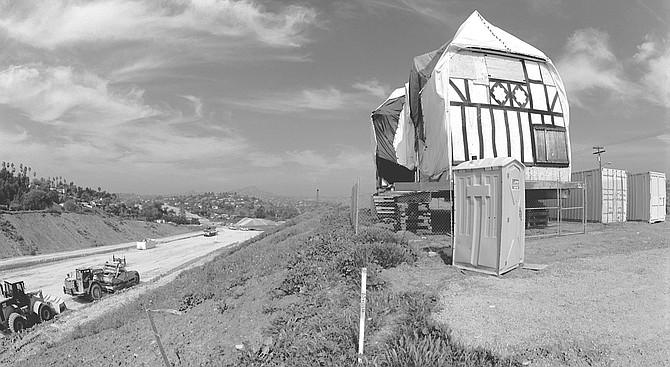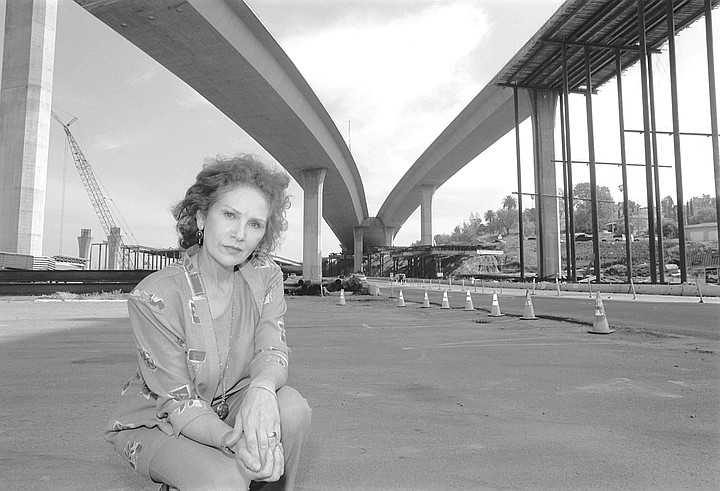 Facebook
Facebook
 X
X
 Instagram
Instagram
 TikTok
TikTok
 Youtube
Youtube

“You know, there are nine million stories in the naked city. And I there’s always a whole bunch when you’re building a big road,” says Helen Ofield, president of the Lemon Grove Historical Society. She refers to the impact of the six-lane, 5.2-mile extension of State Route 125, due to be completed in 2003, according to the California Department of Transportation.

“The Caltrans environmental report contains a wonderful line, something about the ‘heartbreak’ and ‘anguish’ of people who are 'mourning for a lost home,’” Ofield says. “It was quite stirring phraseology in what was otherwise a dry governmental document.”
Approximately 120 Lemon Grove houses have been bought and demolished by Caltrans for the project whose planning began nearly 25 years ago. The money came from $88 million set aside for property acquisition, says Edward J. Cartagena, construction information officer for SR-125, as its known. Some people felt lucky to leave Lemon Grove, considering the alternative: years of noise, dust, and ultimately derangement. Those who were left behind have tried to cope.
Many spared structures were damaged, Ofield says. Worse, from her point of view, the greatest upheaval occurred in the oldest and most historic part of tiny (3.75-square-mile) Lemon Grove. Affected were some of the society’s own sites. One is a Tudor revival from the 1920s, currently up on rollers, waiting to be moved to the comer of Church and Olive, across the street from the society’s Parsonage Museum. “It’s frail and because of the rainy winter, they had to wrap it in plastic: It’s sitting in lonely splendor not far from the construction site.”
Cartagena, for his part, knows many Lemon Grove residents are angry. He speaks with them “on a daily basis,” and tries to keep them informed, if not appeased. “A lot of people will always be against a freeway being built if they’re used to a rural feel,” he says by mobile phone as he traverses the area. But while not denying anyone’s pain, he is obviously proud of the project’s scope, including the 47 support columns for the six freeway interchanges.
“The amount of earth moved in Lemon Grove alone would fill the Seattle King Dome,” he says. To where did the earth get moved? He says it’s often used on site rather than carted away. Right now, some excess sits alongside Routes 54 and 52. It will be offered to municipalities, just as the recycled concrete was. “It often works that, if they can move it, it’s theirs.”
Eighty-year-old Rosemary Putnam, the society’s program chair, lives in a Tudor-revival-style house on property damaged and diminished by SR-125. For six years, she has been negotiating with Caltrans, and since she fears sullying her deal this close to the end, she won’t speak on the record. She doesn’t mind if Ofield speaks for her, however.
“Rosemary has been to hell and back” with Caltrans, says Ofield, who has been a witness for her innumerable times at Caltrans meetings. “She lost her husband in ’93. Before that, he had been dealing with them, and suddenly it’s all on her. First they’re buying her house, then they’re rot. Then they are, then they’re not again, because they have moved the footprint of the freeway to save the topless bar. The obligation of Caltrans is to protect businesses — any businesses, I guess. It’s a bit like the neutron bomb. The people go and you save the buildings. At the other end of Sweetwater Road, in Spring Valley, there’s an adult bookstore. Both businesses were, ironically, saved.
Putnam has been promised things by Caltrans, says Ofield, including a citrus orchard. “And, hmm, they promised her a rose garden, too. Her property is adjacent to the famous old nursery that has taken such a hit.” This is a reference to Hunter’s Nursery. “The Hunters were here before the turn of the last century — growing lemon trees, of course,” says Ofield. “And they will continue, but land of theirs was taken for the big feet that hold up the freeway — the pylons.”
To some other Lemon Grove residents Caltrans has offered a Plexiglas sight-and-sound wall; it’s meant to be less oppressive than a solid one. All but one — another widow (“This little bitty lady,” as Ofield describes her) — said okay. The widow’s preference was for a shield of trees. “Even if they carried the sound, she felt it would be better psychologically.” Trees were not to be. “So the woman found herself in the odd position of talking to Caltrans about putting a door in this wall.” The wall, it seems, will cut across the properties — otherwise, it won’t work correctly, says Ofield; so the door will enable the widow to get at the rest of her property.
Cartagena is a brave man. He will meet with Lemon Grove residents next Thursday to answer questions. Refreshments and a drawing of winners for door prizes will follow his presentation.


“You know, there are nine million stories in the naked city. And I there’s always a whole bunch when you’re building a big road,” says Helen Ofield, president of the Lemon Grove Historical Society. She refers to the impact of the six-lane, 5.2-mile extension of State Route 125, due to be completed in 2003, according to the California Department of Transportation.

“The Caltrans environmental report contains a wonderful line, something about the ‘heartbreak’ and ‘anguish’ of people who are 'mourning for a lost home,’” Ofield says. “It was quite stirring phraseology in what was otherwise a dry governmental document.”
Approximately 120 Lemon Grove houses have been bought and demolished by Caltrans for the project whose planning began nearly 25 years ago. The money came from $88 million set aside for property acquisition, says Edward J. Cartagena, construction information officer for SR-125, as its known. Some people felt lucky to leave Lemon Grove, considering the alternative: years of noise, dust, and ultimately derangement. Those who were left behind have tried to cope.
Many spared structures were damaged, Ofield says. Worse, from her point of view, the greatest upheaval occurred in the oldest and most historic part of tiny (3.75-square-mile) Lemon Grove. Affected were some of the society’s own sites. One is a Tudor revival from the 1920s, currently up on rollers, waiting to be moved to the comer of Church and Olive, across the street from the society’s Parsonage Museum. “It’s frail and because of the rainy winter, they had to wrap it in plastic: It’s sitting in lonely splendor not far from the construction site.”
Cartagena, for his part, knows many Lemon Grove residents are angry. He speaks with them “on a daily basis,” and tries to keep them informed, if not appeased. “A lot of people will always be against a freeway being built if they’re used to a rural feel,” he says by mobile phone as he traverses the area. But while not denying anyone’s pain, he is obviously proud of the project’s scope, including the 47 support columns for the six freeway interchanges.
“The amount of earth moved in Lemon Grove alone would fill the Seattle King Dome,” he says. To where did the earth get moved? He says it’s often used on site rather than carted away. Right now, some excess sits alongside Routes 54 and 52. It will be offered to municipalities, just as the recycled concrete was. “It often works that, if they can move it, it’s theirs.”
Eighty-year-old Rosemary Putnam, the society’s program chair, lives in a Tudor-revival-style house on property damaged and diminished by SR-125. For six years, she has been negotiating with Caltrans, and since she fears sullying her deal this close to the end, she won’t speak on the record. She doesn’t mind if Ofield speaks for her, however.
“Rosemary has been to hell and back” with Caltrans, says Ofield, who has been a witness for her innumerable times at Caltrans meetings. “She lost her husband in ’93. Before that, he had been dealing with them, and suddenly it’s all on her. First they’re buying her house, then they’re rot. Then they are, then they’re not again, because they have moved the footprint of the freeway to save the topless bar. The obligation of Caltrans is to protect businesses — any businesses, I guess. It’s a bit like the neutron bomb. The people go and you save the buildings. At the other end of Sweetwater Road, in Spring Valley, there’s an adult bookstore. Both businesses were, ironically, saved.
Putnam has been promised things by Caltrans, says Ofield, including a citrus orchard. “And, hmm, they promised her a rose garden, too. Her property is adjacent to the famous old nursery that has taken such a hit.” This is a reference to Hunter’s Nursery. “The Hunters were here before the turn of the last century — growing lemon trees, of course,” says Ofield. “And they will continue, but land of theirs was taken for the big feet that hold up the freeway — the pylons.”
To some other Lemon Grove residents Caltrans has offered a Plexiglas sight-and-sound wall; it’s meant to be less oppressive than a solid one. All but one — another widow (“This little bitty lady,” as Ofield describes her) — said okay. The widow’s preference was for a shield of trees. “Even if they carried the sound, she felt it would be better psychologically.” Trees were not to be. “So the woman found herself in the odd position of talking to Caltrans about putting a door in this wall.” The wall, it seems, will cut across the properties — otherwise, it won’t work correctly, says Ofield; so the door will enable the widow to get at the rest of her property.
Cartagena is a brave man. He will meet with Lemon Grove residents next Thursday to answer questions. Refreshments and a drawing of winners for door prizes will follow his presentation.
Comments